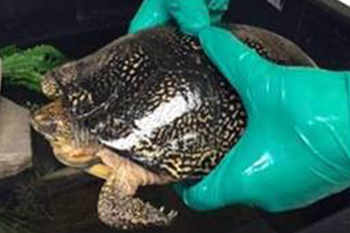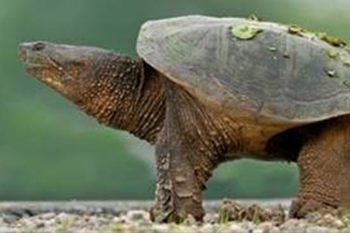
How to help a turtle cross the road (or the path!)
Chambly Canal National Historic Site
Turtles on the road or along the path need our help
If you are visiting the Chambly Canal spot a turtle on the path, please contact Parks Canada staff for assistance.
If you come across a turtle on a road outside of a Parks Canada administered site, follow these steps to properly help it to safety.
Here's what you can do if a turtle crosses the road
Use gloves if possible when handling a turtle

- First and foremost, ensure that you are able to pull over to the side of the road, and exit your vehicle safely. Be aware of oncoming traffic. Although it is important to help turtles on the road, your safety, and that of other road users, should be your number one concern.
- Approach the turtle from behind and pick it up with two hands in the middle of the turtle’s shell like a hamburger using gloves if available.
- Never pick a turtle up by the tail, it can cause serious spinal injuries!
- Help the turtle cross the road in the direction it is facing, even if you think it looks like there is nicer habitat behind it. There is a reason the turtle is going that direction and if you bring it back to where it already was, it will just try to cross the road again.
- Make sure you take the turtle right off the shoulder of the road and into the ditch to make sure it is completely safe and far away from traffic.
- Always wash your hands thoroughly after handling a turtle. Turtles can carry bacteria that aren't harmful to them, but may cause issues for humans.
*See below for instructions on how to help snapping turtles cross the road.
How to help snapping turtles cross the road

- Always approach a snapping turtle from behind.
- Lift the turtle up using the ‘pizza pie’ method: stabilize the tail with one hand, slide your other hand underneath the turtle from behind and lift.
- Keep your hands towards the back half of the turtle. Snapping turtles have long necks that can reach around and snap at you if you are holding it too close to its face.
- If you don’t feel comfortable picking up a snapping turtle, another tip is to have a small shovel in your car to help gently push the turtle from behind to the side of the road.
What to do if you find an injured turtle
If you are visiting a national historic site and you spot any injured wildlife, please contact Parks Canada staff for assistance.
If you find an injured turtle outside of a Parks Canada administered location, follow these steps:
- Make sure she really needs help:
- She is unresponsive.
- She has head or limb injuries, or cracks in her shell.
- She is upside down and unable to roll over on its own, which may indicate dehydration and excessive heat exposure.
- Place the turtle on a damp towel in a well-ventilated trash can or plastic garbage can with a lid that will stay closed. Do not feed or water the turtle.
- Keep the container in a dark, quiet place away from people and pets. Do not add any heat source for the turtle.
- Contact the Éco-Nature rehabilitation center at 450-622-1020 ext. 286 (10 a.m. to 4:30 p.m.) or at sostortue@eco-nature.ca
Remember! Turtles are extremely resilient. Even if the turtle’s injuries look very severe, follow these steps and get it to a rehabilitator as soon as possible. Many turtles with extremely serious injuries have still made full recoveries
Related links
- Date modified :